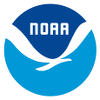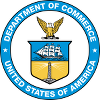Menu
Home > Research by Programs > IPEMF

MODIS Groundtruth Metadata
Modis ground truth sampling results for all cruises are found here: MODIS_groundtruth.xls.
Water collections for ground truthing Modis algorithms
Lake Erie surface water was generally sampled by Niskin bottle, but on occasion a plastic pail was used to get the very near surface (depths labeled as 0.5m). Water samples were taken coincident with profiling with the Satlantic SeaWifs Profiling multi-channel Radiometer. For Niskin bottle collections water samples were collected from a depth between 1 and 2 meters depending on sea conditions and the ability to bring the rosette close to the surface. Water was generally processed immediately on board the ship, however, in September water from stations 489, 402, 947 and M10 was transported to the laboratory at GLERL for filtering.
1) Total Suspended Matter and Inorganic Suspended Matter
Total suspended matter (TSM) was measured by filtering lake water through combusted, rinsed, dried, and weighed 47mm GF/F glass fiber filters. The same sample was also used to determine the contribution of inorganic material by reweighing the final samples after high temperature combustion.
Volumes of water filtered vary between 500 to 2000 ml depending on the particle load, and water is filtered until the filter becomes visually clogged. The filters are frozen until they can be processed for analysis. At that time, filters dried for 18-24 hours in a 65 C degree oven. They are weighed on an analytical balance to the nearest 0.01 mg to obtain the amount of dry suspended material. After the final weight is determined, samples are combusted in a muffle furnace at 400 oC for 2 hours and reweighed on the same balance. It was empirically determined on multiple blank replicates that a correction factor of 0.4 mg was required to account for a small amount of mass loss during the second combustion of the filter.
2) Chlorophyll A Method
The standard chlorophyll procedure is to filter 100 ml of water through a Whatman, 47mm, GF/F filter. Immediately place the filter into a 14ml polypropylene Falcon tube, cap it, freeze it, and keep it frozen and in the dark until analysis. A minimum of duplicate samples were taken at each station. For May and June cruises, triplicates were taken.
Chlorophyll A was analyzed by the Speziale, et al. 1984, Dimethylformamide (DMF) method. Filters were extracted for chlorophyll using 6 or 8 ml of DMF, in a hot water bath for 15 minutes. The solution was mixed, decanted into a flint glass test tube, then placed into the cuvette holder of the model 10-AU-005-CE Turner fluorometer. The instrument reading was recorded. Then, 2-3 drops of 10% HCl were added to each test tube. The test tube was covered with Parafilm, then shaken and let to sit until all the samples were read the first time. After acid addition, the samples were read a second time. This value was recorded. Both readings were input into an excel spreadsheet which calculated the corrected chlorophyll and the ratio of the two readings (acid ratio). DMF blanks were measured at the beginning of work on the fluorometer and at the end of each day, prior to solid standard measurement. Solid standard values for both “high” and “low” were measured before and after each day’s measurements. Records were kept of the solid standard measurements throughout the year for quality control purposes.
Speziale, B.J., Schreiner, S.P., Giammatteo, P.A., and Schindler, J.E. 1984, “Comparison of N,N-Dimethylformamide, Dimethyl Sulfoxide, and Acetone for Extraction of Phytoplankton Chlorophyll”, Can.J.Fish.Aquat.Sci., Vol 41 pp1519-1522.
3) Dissolved Organic Carbon (DOC/TOC)
Water for DOC was processed by filtering lakewater through a 25mm pre-combusted (400 oC for 4 hours) GF/F filter. Filtrate was collected into a pre-combusted glass beaker using a filter dome and then poured in triplicate into either pre-combusted glass tubes for the Shimadzu analyzer, or 14ml polypropylene falcon tubes, that were well rinsed with an aliquot of sample prior to filling. Samples were stored frozen until analysis.
The dissolved organic carbon was analyzed via the high temperature combustion method, # 5310 B from the Standard Methods for the Examination of Water and Wastewater,20th Edition 1998, M.A.H. Franson editor, American Public Health Association, pages 5-20 through 5-22.
The Shimadzu TOC5000 defines total organic carbon as “Non-purgeable organic carbon” (NPOC). Total organic carbon in the solution was determined after both the Shimadzu TOC5000 and the blank readings were determined to be stable. Stability was accomplished and determined by acid regeneration of the column, first, and running blanks through the column to lower the instrument/catalyst background. Further, several standard curves were generated using solutions of potassium bitphthalate of 0 to 5 mg/L and 0 to 10 mg/L carbon to insure instrument stability and good calibration. Calibration curves were forced through zero by blank correction. Manual mode was used for initial standard calibrations and sample analysis. When, automated mode was used the same above procedure was followed to insure stability before the automatic feature was engaged and the instrument was monitored.
Samples were kept frozen and covered in pre-combusted Shimadzu glass vials, or in Falcon 14ml test tubes (for some late season samples) until analysis. Then samples were placed in the carousel in the pre-combusted vials for analysis.
Standards and acid were contained in large, clean glass vials. Acid was added automatically to the samples prior to automatic sample injection into the instrument. Non-purgeable organic carbon (NPOC) was determined by the instrument as peak area measured, then calculated (using the calibration curve generated in auto mode) as carbon. Where data appeared to be outside the stream of prior values, or the range of replicates appeared higher than 3-5 %, samples were re-analyzed or the triplicate sample was analyzed, or both.
Contact Information:
Tom Johengen
CILER
University of Michigan
phone: (734)741-2203
email:


